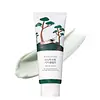What's inside
What's inside
 Key Ingredients
Key Ingredients

 Benefits
Benefits

 Concerns
Concerns

 Ingredients Side-by-side
Ingredients Side-by-side

Water
Skin ConditioningGlycerin
HumectantSodium Cocoyl Isethionate
CleansingLauramidopropyl Betaine
CleansingDisodium Cocoamphodiacetate
CleansingSodium Chloride
MaskingCalamine
AbsorbentSorbitan Olivate
EmulsifyingGlycol Distearate
EmollientSalicylic Acid
MaskingGlycol Stearate
EmollientCitric Acid
BufferingDipropylene Glycol
HumectantHydroxyacetophenone
AntioxidantParfum
MaskingCaprylyl Glycol
EmollientHexylene Glycol
EmulsifyingDisodium EDTA
Ethylhexylglycerin
Skin ConditioningButylene Glycol
HumectantDipotassium Glycyrrhizate
Humectant1,2-Hexanediol
Skin ConditioningHouttuynia Cordata Extract
Skin ConditioningCentella Asiatica Extract
CleansingBeta Vulgaris Root Extract
Skin ConditioningTocopherol
AntioxidantLimonene
PerfumingLinalool
PerfumingWater, Glycerin, Sodium Cocoyl Isethionate, Lauramidopropyl Betaine, Disodium Cocoamphodiacetate, Sodium Chloride, Calamine, Sorbitan Olivate, Glycol Distearate, Salicylic Acid, Glycol Stearate, Citric Acid, Dipropylene Glycol, Hydroxyacetophenone, Parfum, Caprylyl Glycol, Hexylene Glycol, Disodium EDTA, Ethylhexylglycerin, Butylene Glycol, Dipotassium Glycyrrhizate, 1,2-Hexanediol, Houttuynia Cordata Extract, Centella Asiatica Extract, Beta Vulgaris Root Extract, Tocopherol, Limonene, Linalool
Water
Skin ConditioningGlycerin
HumectantHydrogenated Palm Acid
Potassium Hydroxide
BufferingPotassium Cocoyl Glycinate
Camellia Sinensis Leaf Extract
AntimicrobialCladosiphon Okamuranus Extract
Skin ConditioningSalix Alba Bark Extract
AstringentCoffea Arabica Seed Extract
MaskingCitrus Aurantium Bergamia Leaf Extract
AstringentSalicylic Acid
MaskingCentella Asiatica Leaf Extract
Skin ConditioningPinus Densiflora Leaf Extract
AntimicrobialCentella Asiatica Extract
CleansingHyaluronic Acid
HumectantHydrolyzed Hyaluronic Acid
HumectantSodium Hyaluronate
HumectantButylene Glycol
HumectantEthylhexylglycerin
Skin ConditioningGardenia Florida Fruit Extract
Skin ConditioningGlycoproteins
Skin ConditioningCapryloyl Salicylic Acid
ExfoliatingAsiatic Acid
Skin ConditioningAsiaticoside
AntioxidantMadecassic Acid
Skin ConditioningMadecassoside
AntioxidantGlyceryl Stearate
EmollientDextrin
AbsorbentDecyl Glucoside
CleansingAcrylates/C10-30 Alkyl Acrylate Crosspolymer
Emulsion Stabilising1,2-Hexanediol
Skin ConditioningSodium Phytate
Water, Glycerin, Hydrogenated Palm Acid, Potassium Hydroxide, Potassium Cocoyl Glycinate, Camellia Sinensis Leaf Extract, Cladosiphon Okamuranus Extract, Salix Alba Bark Extract, Coffea Arabica Seed Extract, Citrus Aurantium Bergamia Leaf Extract, Salicylic Acid, Centella Asiatica Leaf Extract, Pinus Densiflora Leaf Extract, Centella Asiatica Extract, Hyaluronic Acid, Hydrolyzed Hyaluronic Acid, Sodium Hyaluronate, Butylene Glycol, Ethylhexylglycerin, Gardenia Florida Fruit Extract, Glycoproteins, Capryloyl Salicylic Acid, Asiatic Acid, Asiaticoside, Madecassic Acid, Madecassoside, Glyceryl Stearate, Dextrin, Decyl Glucoside, Acrylates/C10-30 Alkyl Acrylate Crosspolymer, 1,2-Hexanediol, Sodium Phytate
 Reviews
Reviews

Ingredients Explained
These ingredients are found in both products.
Ingredients higher up in an ingredient list are typically present in a larger amount.
1,2-Hexanediol is a synthetic liquid and another multi-functional powerhouse.
It is a:
- Humectant, drawing moisture into the skin
- Emollient, helping to soften skin
- Solvent, dispersing and stabilizing formulas
- Preservative booster, enhancing the antimicrobial activity of other preservatives
Butylene Glycol (or BG) is used within cosmetic products for a few different reasons:
Overall, Butylene Glycol is a safe and well-rounded ingredient that works well with other ingredients.
Though this ingredient works well with most skin types, some people with sensitive skin may experience a reaction such as allergic rashes, closed comedones, or itchiness.
Learn more about Butylene GlycolCentella Asiatica Extract (Centella) is derived from an herb native to Southeast Asia. It is famous for its anti-inflammatory and soothing properties.
Centella is rich in antioxidants and amino acids, such as Madecassic Acid and Asiaticoside.
Studies show the compounds in centella help with:
The combination of all these properties makes centella effective at soothing, hydrating, and protecting the skin.
Other great components of centella include Vitamin A, vitamin C, several B vitamins, and Asiatic Acid.
Fun fact: Centella has been used as a medicine and in food for many centuries. As a medicine, it is used to treat burns, scratches, and wounds.
Learn more about Centella Asiatica ExtractEthylhexylglycerin (we can't pronounce this either) is commonly used as a preservative and skin softener. It is derived from glyceryl.
You might see Ethylhexylglycerin often paired with other preservatives such as phenoxyethanol. Ethylhexylglycerin has been found to increase the effectiveness of these other preservatives.
Glycerin is already naturally found in your skin. It helps moisturize and protect your skin.
A study from 2016 found glycerin to be more effective as a humectant than AHAs and hyaluronic acid.
As a humectant, it helps the skin stay hydrated by pulling moisture to your skin. The low molecular weight of glycerin allows it to pull moisture into the deeper layers of your skin.
Hydrated skin improves your skin barrier; Your skin barrier helps protect against irritants and bacteria.
Glycerin has also been found to have antimicrobial and antiviral properties. Due to these properties, glycerin is often used in wound and burn treatments.
In cosmetics, glycerin is usually derived from plants such as soybean or palm. However, it can also be sourced from animals, such as tallow or animal fat.
This ingredient is organic, colorless, odorless, and non-toxic.
Glycerin is the name for this ingredient in American English. British English uses Glycerol/Glycerine.
Learn more about GlycerinSalicylic Acid (also known as beta hydroxy acid or BHA) is a well-known ingredient for treating skin that struggles with acne and clogged pores. It exfoliates both the skin's surface and deep within the pores to help clear out buildup, control oil, and reduce inflammation.
Unlike AHAs (alpha hydroxy acids), salicylic acid is oil-soluble. This allows it to penetrate into pores which makes it especially effective for treating blackheads and preventing future breakouts.
Salicylic acid is also known for its soothing properties. It has a similar structure to aspirin and can calm inflamed or irritated skin, making it a good option for acne-prone skin that is also sensitive.
Concentrations of 0.5-2% are recognized by the U.S. FDA as an over-the-counter topical acne product.
It can cause irritation and/or dryness if one's skin already has a compromised moisture barrier, so it's best to focus on repairing that before introducing this ingredient into your routine.
While salicylic acid does not increase sun sensitivity, it’s still important to wear sunscreen daily to protect your skin.
If you are looking for the ingredient called BHA or Butylated Hydroxyanisole, click here.
Learn more about Salicylic AcidWater. It's the most common cosmetic ingredient of all. You'll usually see it at the top of ingredient lists, meaning that it makes up the largest part of the product.
So why is it so popular? Water most often acts as a solvent - this means that it helps dissolve other ingredients into the formulation.
You'll also recognize water as that liquid we all need to stay alive. If you see this, drink a glass of water. Stay hydrated!
Learn more about Water